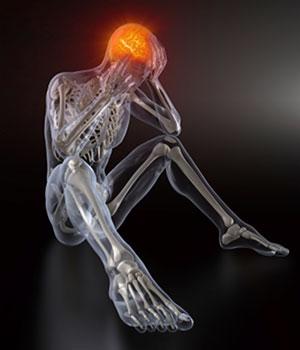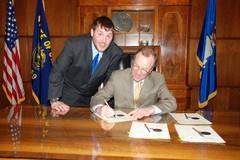Oregon Concussion Laws - Frequenlty Asked Questions
- What is a concussion?
- How can we be sure that a player has a concussion?
- What if my team includes persons over and under the age of 18 years?
- What kind of training must I ensure that all coaches in our district receive?
- What about the parent or individual who helps out but is not a coach?
- What kind of a tracking system is best to ensure regular training for all coaches?
- What is considered “proper medical treatment” under Max’s and Jenna’s Laws?
- How can I ensure safe return to competition for athletes after a concussion?
- How does concussion affect classroom performance?
- Does our school district need a certified athletic trainer?
- What about assessment tools?
What is a concussion?
It’s a brain injury and should be taken seriously.
Only recently have we begun to understand what happens to the brain during a concussion. In the past, people used the analogy that a concussion was a “bruise to the brain.” It is actually a very complex event. Common sports injuries such as torn ligaments and broken bones are structural injuries that can be seen on x-rays or felt during an examination. A concussion, however, affects how the brain works: It’s a problem of function, not structure.
A concussion results in a temporary, or in some cases lasting, disruption of normal brain function. It occurs when the brain is violently rocked back and forth or twisted inside the skull as a result of a blow to the head or body. Even what appears to be a mild jolt or blow to the head or body can cause the brain to shift or rotate suddenly within the skull. This sudden movement of the brain causes stretching and tearing of brain cells, damaging the cells and creating chemical changes in the brain. Those chemical changes result in physical, emotional, and cognitive symptoms. Once those changes occur, the brain is vulnerable to further injury and sensitive to any increased stress until it fully recovers.
Studies suggest that it usually takes brain cells about three weeks to regain normal function, but it can take much longer. Concussion symptoms can last from a few days to several months. Some might never go away. Concussions can cause symptoms that interfere with school, work, and social life.
Although most common in sports such as football, soccer, and basketball, concussion or mild TBI can occur in any sport or physical activity. Loss of consciousness is not required to have a concussion; in fact, fewer than 10 percent of athletes with a concussion are knocked out.
Young athletes are particularly vulnerable to the effects of concussion.They are more likely than older athletes to experience problems after concussion and often take longer to recover. Teenagers also appear to be especially vulnerable to a second brain injury while the brain is still healing from an initial concussion. This second impact can result in long-term impairment or even death.
The importance of proper recognition and management of concussed young athletes cannot be over-emphasized.
How can we be sure that a player has a concussion?
You can’t. Only an appropriately trained healthcare professional can diagnose a concussion. Both Max’s and Jenna’s Laws require that when a concussion is suspected, the player must be removed from play. “When in doubt, sit them out.”
What if my team includes persons over and under the age of 18 years?
If a person coaches or officiates at a non-school athletic event that includes persons 17 years of age or younger, Jenna’s Law will apply. (Max’s Law applies to any school-sponsored athletic event irrespective of the athletes’ ages.) Coaches and referees must receive annual training and policies must be adopted. Sports organizations must additionally ensure that parent(s)/guardian(s) receive training materials and be educated about concussions. A tracking system must also be in place to document that the parent(s)/guardian(s) of every team member 17 years or younger has received and reviewed the training materials with their child.
What kind of training must I ensure that all coaches in our district receive?
You must provide Recognize, Remove, Refer and Return training to ensure that all coaches:
-
Know how to recognize the signs and symptoms of a concussion.
-
Know and use strategies to reduce the risk of a concussion.
-
Know how to seek proper medical treatment for a child when a concussion is suspected..
-
Know protocol for safe, graduated return to activity.
You can find approved trainings at:
Brain 101
CDC
NFHS
OSAA
What about the parent or individual who helps out but is not a coach?
If a person does not regularly serve as a coach or referee, the provisions of Jenna’s law do not apply. If parents or other volunteers help the coach either on or off the field, they are not bound by the provisions of Jenna’s Law.
What kind of a tracking system is best to ensure regular training for all coaches?
A tracking system can be a simple paper file or a more sophisticated computer application. But all paid and volunteer coaches in your school or organization must receive documented annual training within a 12 month period each year. Though not required by law, tracking systems to monitor concussion histories and return-to-activity for young athletes are also a good idea.
What is considered “proper medical treatment” under Max’s and Jenna’s Laws?
Under Max’s and Jenna’s Laws, proper medical treatment means treatment by a licensed healthcare professional within their scope of practice. The term healthcare professional is limited to a physician (MD), physician’s assistant (PA), or doctor of osteopathy (DO) licensed by the Oregon State Board of Medicine or a nurse practitioner licensed by the Oregon State Board of Nursing.
How can I ensure safe return to competition for athletes after a concussion?
Return-to-play is a medical decision that involves a medical release. A gradual return-to-activity protocol is recommended once an athlete has been cleared by a healthcare professional. Even with a medical release, student athletes, parents, teachers, trainers, and coaches might recognize lingering symptoms. For that reason, it is recommended that you designate a point person in your school or organization to coordinate communication with the medical provider, student, parents, teachers, trainers, and coaches to ensure the best possible recovery.
How does concussion affect classroom performance?
Taxing the brain with academic activity after a concussion can impede or prolong recovery. When a concussion occurs, a child looks normal, and teachers might be unaware of a student’s cognitive difficulties during recovery. A school-wide concussion management plan can inform teachers when academic accommodations are needed.
Does our school district need a certified athletic trainer?
Hiring a certified athletic trainer (ATC) is recommended. They are ideal point persons in a school-wide concussion management program who can provide systematic communication with the student, parent(s)/guardian(s), teachers, coaches, and healthcare professionals when a concussion occurs. An ATC is the ideal person to supervise an individualized return-to-activity plan for an athlete. S/he can also provide effective tracking of coach trainings and provide accurate documentation of each athlete’s recovery.
Most school districts cannot afford to hire an ATC. If that is the situation for your school, a volunteer community healthcare professional might be willing to help.
What about assessment tools?
Baseline and post-injury assessments provide the best way to determine any impairment an athlete has as a result of a concussion. These assessments are only tools. No return-to-activity decisions should be made on results of any test or tests alone. Test results should always be shared with the parent and the primary healthcare professional.
The current recommendations for concussion assessments suggest that both baseline and post-injury assessments include:
-
A neurocognitive mental status test
-
Balance tests
-
Use of a symptom scale or checklist.
If a school district decides to incorporate one or more of these tests into a concussion management program, careful consideration should be given to who is credentialed to give the test and interpret the results and under what conditions and at what intervals the tests should be given.
Neurocognitive Mental Status Tests. Several computerized programs provide neurocognitive baseline assessments. A school district should seek legal and risk management counsel before subscribing to any computerized neurocognitive test. OCAMP does not endorse any of these neurocognitive tests. Some providers of these products are:•
The Standard Assessment of Concussion (SAC). The SAC is a sideline mental status assessment that can be used at a game site immediately following injury. The SAC requires 5–7 minutes to administer and is designed for use by individuals with no prior expertise in neurocognitive test administration. The SAC assesses orientation, immediate memory, concentration, and delayed recall following injury. The assessment also incorporates a neurological screening focusing on strength, sensation, and coordination.
Balance Tests. The Balance Error Scoring System (BESS) is a standardized assessment of postural stability. The BESS consists of six separate 20 second balance tests that the athlete performs in different stances and on different surfaces.
Symptom Scale/Checklist. Graded symptom scales (GSS) are self-administered scales that identify the number and severity of post-concussive symptoms. The student-athlete is instructed to circle the appropriate number for each symptom, indicating the presence and severity of a given symptom. Each column is totaled, and the total sum indicates the student-athlete’s symptom score. A GSS should be used following initial injury, as well as during the recovery process following both rest and exertion.
Max’s Law (2010) applies only to Oregon School Districts.
Jenna’s Law (2014) extends the intent of Max’s Law to Oregon youth sports and referee organizations.
Both Max’s and Jenna’s Laws require school and non-school youth athletic programs to:
-
Create policies and procedures.
-
Provide training.
-
Track training.
-
Ensure that staff practice good concussion management.
-
Restrict play when a concussion is suspected.
-
Provide educational materials/programs.
Max’s Law (OAR 581-022-0421) was enacted in 2010 and requires Oregon school districts to implement concussion management guidelines for student athletes. Read the law here.
Meet Max (click for video)
In the fall of 2001, high-school quarterback Max Conradt, 17, sustained a concussion during a game. With no medical confirmation that his first concussion had cleared, Max started in the next game. He collapsed at halftime due to massive bleeding in his brain. Three critical brain surgeries saved his life, but he was in a coma for three months. Once he became physically stable, Max began a long period of rehabilitation in several institutions. Max’s remarkable spirit has led to great progress, but some activities of daily life remain a challenge.
Jenna’s Law (SB 721) was enacted in 2014 and requires Oregon Non-School Sports and Officiating Organizations to implement concussion management guidelines for all teams that include children 17 years of age and younger. Read the law here.
Meet Jenna (click for video)
At age 19, Jenna Sneva won gold at a national skiing competition and was on track to attain her Olympic dreams. The central Oregon teen, fueled by the adrenaline rush of extreme sports, thought nothing could stop her until debilitating headaches and an inability to focus brought those dreams to an abrupt halt. After many concussions and not enough time to heal, Jenna was diagnosed with post-concussion syndrome. Getting angry at her doctor and the world did not fix her prognosis; Jenna went on to attend school and graduated from Oregon State University, but she will always struggle in many aspects of her life and will not ski again.



